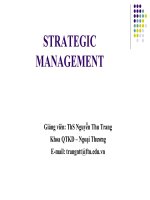Slide bài giảng môn quản trị chiến lược TS từ văn bình chương 3
Bạn đang xem bản rút gọn của tài liệu. Xem và tải ngay bản đầy đủ của tài liệu tại đây (1.26 MB, 53 trang )
The External
Assessment
Chapter Three
Chapter Objectives
1. Describe how to conduct an external strategic2.
3.
4.
5.
management audit.
Discuss 10 major external forces that affect organizations:
economic, social, cultural, demographic, environmental,
political, governmental, legal, technological, and
competitive.
Describe key sources of external information, including the
Internet.
Discuss important forecasting tools used in strategic
management.
Discuss the importance of monitoring external trends and
events.
Copyright ©2013 Pearson Education
3-2
Chapter Objectives (cont.)
6.
7.
Explain how to develop an EFE Matrix.
Explain how to develop a Competitive Profile
Matrix.
8. Discuss the importance of gathering
competitive intelligence.
9. Describe the trend toward cooperation among
competitors.
10.Discuss market commonality and resource
similarity in relation to competitive analysis.
Copyright ©2013 Pearson Education
3-3
External Audit
External audit
focuses on identifying and evaluating trends
and events beyond the control of a single firm
reveals key opportunities and threats
confronting an organization so that managers
can formulate strategies to take advantage of
the opportunities and avoid or reduce the
impact of threats
Copyright ©2013 Pearson Education
3-4
The Nature of an External Audit
The external audit is aimed at identifying key
variables that offer actionable responses
Firms should be able to respond either
offensively or defensively to the factors by
formulating strategies that take advantage of
external opportunities or that minimize the
impact of potential threats.
Copyright ©2013 Pearson Education
3-5
A Comprehensive StrategicManagement Model
Copyright ©2013 Pearson Education
3-6
Key External Forces
External forces can be divided into five broad
categories:
1.economic forces
2.social, cultural, demographic, and natural
environment forces
3.political, governmental, and legal forces
4.technological forces
5.competitive forces
Copyright ©2013 Pearson Education
3-7
Relationships Between Key External
Forces and an Organization
Copyright ©2013 Pearson Education
3-8
The Process of Performing an
External Audit
First, gather competitive intelligence and
information about economic, social, cultural,
demographic, environmental, political,
governmental, legal, and technological trends.
Copyright ©2013 Pearson Education
3-9
The Process of Performing an
External Audit
Information should be assimilated and
evaluated
A final list of the most important key external
factors should be communicated
Copyright ©2013 Pearson Education
3-10
The Process of Performing an
External Audit
Key external factors should be:
1.important to achieving long-term and annual
objectives
2.measurable
3.applicable to all competing firms, and
4.hierarchical in the sense that some will pertain to
the overall company and others will be more
narrowly focused on functional or divisional areas
Copyright ©2013 Pearson Education
3-11
The Industrial Organization
(I/O) View
The Industrial Organization (I/O) approach to
competitive advantage advocates that external
(industry) factors are more important than
internal factors in a firm for achieving
competitive advantage.
Copyright ©2013 Pearson Education
3-12
The Industrial Organization
(I/O) View
Firm performance
is based more on
industry properties
Copyright ©2013 Pearson Education
3-13
Economic Forces
Copyright ©2013 Pearson Education
3-14
Advantages and Disadvantages
of a Weak Dollar
Copyright ©2013 Pearson Education
3-15
Social, Cultural, Demographic, and
Natural Environmental Forces
U.S. Facts
Aging population
Less white
Widening gap between rich & poor
2025 = 18.5% population > 65 years
2075 = no ethnic or racial majority
Copyright ©2013 Pearson Education
3-16
Social, Cultural, Demographic, and
Natural Environmental Forces
Facts
World population 7 billion
World population = 8 billion by 2028
World population = 9 billion by 2054
U.S. population > 310 million
Copyright ©2013 Pearson Education
3-17
Key Social, Cultural, Demographic, and
Natural Environment Variables
3-18
Copyright ©2013 Pearson Education
Political, Governmental, and
Legal Forces
The increasing global interdependence among
economies, markets, governments, and
organizations makes it imperative that firms
consider the possible impact of political
variables on the formulation and
implementation of competitive strategies.
Copyright ©2013 Pearson Education
3-19
Political, Government, and
Legal Variables
Copyright ©2013 Pearson Education
3-20
American Labor Unions
The extent that a state is unionized can be a
significant political factor in strategic planning
decisions as related to manufacturing plant
location and other operational matters
The size of American labor unions has fallen
sharply in the last decade due in large part to
erosion of the U.S. manufacturing base
Copyright ©2013 Pearson Education
3-21
Technological Forces
The Internet has changed the very nature of
opportunities and threats by:
altering the life cycles of products,
increasing the speed of distribution,
creating new products and services,
erasing limitations of traditional geographic
markets,
changing the historical trade-off between
production standardization and flexibility.
Copyright ©2013 Pearson Education
3-22
Technological Forces
The Internet is altering economies of scale,
changing entry barriers, and redefining the
relationship between industries and various
suppliers, creditors, customers, and
competitors
Copyright ©2013 Pearson Education
3-23
Technological Forces
Many firms now have a Chief Information
Officer (CIO) and a Chief Technology Officer
(CTO) who work together to ensure that
information needed to formulate, implement,
and evaluate strategies is available where and
when it is needed
Copyright ©2013 Pearson Education
3-24
Technological Forces
Technological advancements can:
Create new markets,
Result in a proliferation of new and improved
products,
Change the relative competitive cost positions in
an industry,
Render existing products and services obsolete.
Copyright ©2013 Pearson Education
3-25









